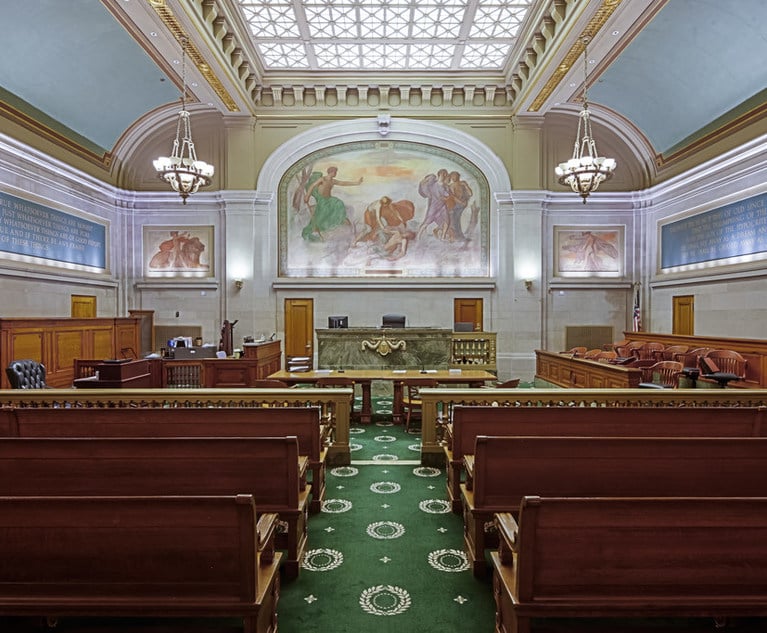Third Circuit Rules Cross on County Seal and Flag Not Discriminatory
Third Circuit Judge Thomas Hardiman reasoned that per the 2018 Supreme Court decision in American Legion v. American Humanist Association, a longstanding government symbol holds the presumption of constitutionality.
August 09, 2019 at 10:00 AM
6 minute read
The original version of this story was published on The Legal Intelligencer
 Lehigh County, Pennsylvania, flag.
Lehigh County, Pennsylvania, flag.
A federal appeals court has rejected an atheist group’s challenge to Lehigh County’s official seal, ruling that the cross featured on it is not discriminatory to non-Christians.
On Thursday, the U.S. Court of Appeals for the Third Circuit reversed a lower court’s decision that the seal—showing a cross superimposed on a blue background in between a wreath of secular images—was unconstitutional.
After complaining to the county to no avail about the seal, which has been used since 1944, the Freedom From Religion Foundation filed a lawsuit in 2016. A federal judge agreed with the group’s argument that the cross had no secular purpose on the seal, and that a reasonable observer would see it as an endorsement of religion, in violation of the separation of church and state.
However, Third Circuit Judge Thomas Hardiman reasoned that per the 2018 Supreme Court decision in American Legion v. American Humanist Association, a longstanding government symbol holds the presumption of constitutionality.
“In American Legion, the Supreme Court held that the presumption applies to all ‘established, religiously expressive monuments, symbols, and practices,’” Hardiman wrote. “Lehigh County’s seal checks those boxes. It was adopted almost 75 years ago, so it is established. It depicts a Latin cross, so it is religiously expressive. And it represents the county and its government, so it is a symbol.”
Hardiman added that since the cross is pictured with secular images, such as a farm, a courthouse and factories, it can have a “dual significance partaking of both religion and government.”
“Courts are not to focus solely on the religious component in challenged government displays,” he said, “they should consider the overall message conveyed and the broader context in which the display appears.”
The judge said that religious symbols can be part of a community’s identity, “valued for more than just ‘their religious roots.’”
On the other hand, Hardiman reasoned, removing the cross would demonstrate hostility toward religion, “inviting disputes over similar longstanding symbols nationwide.”
Hardiman was joined by Third Circuit Judges Stephanos Bibas and Cheryl Ann Krause.
The case drew the attention and support of several advocacy groups for both sides in the way of amicus briefs. The FFRF was joined by the American Civil Liberties Union and the Anti-Defamation League, to name a few, while Lehigh County was supported by several religious liberty groups and a collection of 15 states including Alabama, Arizona, Arkansas, Colorado, Indiana, Kansas, Louisiana, Missouri, Nebraska, Ohio, Oklahoma, South Carolina, Texas, Utah and West Virginia.
Lehigh County is represented by the Becket Fund for Religious Liberty in Washington, D.C.
“It is common sense that religion played a role in the lives of our nation’s early settlers. Recognizing that is just as constitutional as honoring symbols like the Liberty Bell,” Diana Verm, senior counsel at Becket, said in a statement Thursday. “It is only right that Lehigh County can continue honoring its history and culture.”
FFRF’s attorney, Marcus B. Schneider of Steele Schneider in Pittsburgh, did not respond to requests for comment. Richard Katskee, a lawyer with Americans United for Separation of Church and State, which filed a brief in support of the FFRF on behalf of his organization and the ACLU, said the decision was not surprising given the Supreme Court’s stance on the issue.
As for the Third Circuit’s approach of looking at the whole seal, not just the cross, Katskee said case law states “you are supposed to take it into context, but when it’s a big cross surrounded by other stuff I don’t think that’s how it’s supposed to work.”
While noting that the case is essentially over, Katskee said the groups he represents will continue to take on similar issues.
“These are issues that matter to lots of people including us, issues like who we are as a country and who counts and who doesn’t. We’re always interested in cases that define the boundaries of religion and government because they deeply affect people,” he said.
Eugene Volokh, who teaches constitutional and church-state relations law at the University of California, Los Angeles School of Law, said the Third Circuit’s decision is in line with Supreme Court precedent and generally makes sense.
Volokh noted that before the Supreme Court’s American Legion decision, there was plenty of precedent that barred religious symbolism of any kind on government symbols, but those holdings are now obsolete.
He also agreed with the approach of looking at the seal as a whole in determining its constitutionality.
“It is certainly true that this isn’t just a cross,” Volokh said of the seal. “I do think if the seal was solely a Latin cross, somebody could say that there is something more untoward with that, because then it doesn’t look like just a seal any more.”
Volokh pointed out that, right or wrong, religious references and symbols in government permeate American history.
“Look at the Declaration of Independence; it has religious references in the opening and closing paragraphs,” Volokh said. “I take it that a city or county would be free to post the Declaration of Independence. Does it have a religious component? Yes. But that’s the way people talked back then.”
University of Virginia School of Law professor Douglas Laycock also agreed with the Third Circuit’s decision.
“These symbols are what remain from former establishments, whether or not the county would adopt such a symbol today or vote to establish Christianity in any other way today,” Laycock said. “But they are all protected by a grandfather clause for things adopted or erected long ago. And the judges are right that trying to eliminate all of them would be misunderstood by those who support such displays, and might be even more religiously divisive than leaving them in place.”
This content has been archived. It is available through our partners, LexisNexis® and Bloomberg Law.
To view this content, please continue to their sites.
Not a Lexis Subscriber?
Subscribe Now
Not a Bloomberg Law Subscriber?
Subscribe Now
NOT FOR REPRINT
© 2025 ALM Global, LLC, All Rights Reserved. Request academic re-use from www.copyright.com. All other uses, submit a request to [email protected]. For more information visit Asset & Logo Licensing.
You Might Like
View All
‘The Decision Will Help Others’: NJ Supreme Court Reverses Appellate Div. in OPRA Claim Over Body-Worn Camera Footage
5 minute read
Longtime AOC Director Glenn Grant to Step Down, Assignment Judge to Take Over
4 minute read

Trending Stories
- 1New York-Based Skadden Team Joins White & Case Group in Mexico City for Citigroup Demerger
- 2No Two Wildfires Alike: Lawyers Take Different Legal Strategies in California
- 3Poop-Themed Dog Toy OK as Parody, but Still Tarnished Jack Daniel’s Brand, Court Says
- 4Meet the New President of NY's Association of Trial Court Jurists
- 5Lawyers' Phones Are Ringing: What Should Employers Do If ICE Raids Their Business?
Who Got The Work
J. Brugh Lower of Gibbons has entered an appearance for industrial equipment supplier Devco Corporation in a pending trademark infringement lawsuit. The suit, accusing the defendant of selling knock-off Graco products, was filed Dec. 18 in New Jersey District Court by Rivkin Radler on behalf of Graco Inc. and Graco Minnesota. The case, assigned to U.S. District Judge Zahid N. Quraishi, is 3:24-cv-11294, Graco Inc. et al v. Devco Corporation.
Who Got The Work
Rebecca Maller-Stein and Kent A. Yalowitz of Arnold & Porter Kaye Scholer have entered their appearances for Hanaco Venture Capital and its executives, Lior Prosor and David Frankel, in a pending securities lawsuit. The action, filed on Dec. 24 in New York Southern District Court by Zell, Aron & Co. on behalf of Goldeneye Advisors, accuses the defendants of negligently and fraudulently managing the plaintiff's $1 million investment. The case, assigned to U.S. District Judge Vernon S. Broderick, is 1:24-cv-09918, Goldeneye Advisors, LLC v. Hanaco Venture Capital, Ltd. et al.
Who Got The Work
Attorneys from A&O Shearman has stepped in as defense counsel for Toronto-Dominion Bank and other defendants in a pending securities class action. The suit, filed Dec. 11 in New York Southern District Court by Bleichmar Fonti & Auld, accuses the defendants of concealing the bank's 'pervasive' deficiencies in regards to its compliance with the Bank Secrecy Act and the quality of its anti-money laundering controls. The case, assigned to U.S. District Judge Arun Subramanian, is 1:24-cv-09445, Gonzalez v. The Toronto-Dominion Bank et al.
Who Got The Work
Crown Castle International, a Pennsylvania company providing shared communications infrastructure, has turned to Luke D. Wolf of Gordon Rees Scully Mansukhani to fend off a pending breach-of-contract lawsuit. The court action, filed Nov. 25 in Michigan Eastern District Court by Hooper Hathaway PC on behalf of The Town Residences LLC, accuses Crown Castle of failing to transfer approximately $30,000 in utility payments from T-Mobile in breach of a roof-top lease and assignment agreement. The case, assigned to U.S. District Judge Susan K. Declercq, is 2:24-cv-13131, The Town Residences LLC v. T-Mobile US, Inc. et al.
Who Got The Work
Wilfred P. Coronato and Daniel M. Schwartz of McCarter & English have stepped in as defense counsel to Electrolux Home Products Inc. in a pending product liability lawsuit. The court action, filed Nov. 26 in New York Eastern District Court by Poulos Lopiccolo PC and Nagel Rice LLP on behalf of David Stern, alleges that the defendant's refrigerators’ drawers and shelving repeatedly break and fall apart within months after purchase. The case, assigned to U.S. District Judge Joan M. Azrack, is 2:24-cv-08204, Stern v. Electrolux Home Products, Inc.
Featured Firms
Law Offices of Gary Martin Hays & Associates, P.C.
(470) 294-1674
Law Offices of Mark E. Salomone
(857) 444-6468
Smith & Hassler
(713) 739-1250






